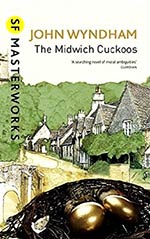
![]() charlesdee
charlesdee
6/12/2012
![]()
In The Trillion Year Spree, Brian Aldiss's 1986 expansion of his 1973 history of science fiction The Billion Year Spree, the author dismisses John Wyndham as the author of "cosy catastrophes." He defines the genre as one in which the hero meets catastrophe from the comfort of his dining room. The best of all things British will see him through. Ranking Wyndham as a cosyist makes him the Agatha Christie of SF. This sounds like one generation dismissing an earlier, but Wyndham was only about ten years Aldiss's senior. Aldiss was part of a vanguard associated with the New Worldswriters and the British New Wave of SF writers. Viewed from that vantage point, Wyndham's bestsellers do seem like period pieces that happened to coexist with the coming avant garde.
But they are enjoyable period pieces. The Midwich Cuckoos, more famous as the film The Village of the Damned involves a small English village not to far outside London that loses a day to an unexplained visitation from a force that puts the village inhabitants to sleep for twenty-four hours. Except for the handful of unlucky villagers who die from exposure or house fires, everyone wakes up none the worse for wear. It is only a month or so later that the pregnancy of every woman of childbearing age in Midwich announces that something more unusual than an few extra hours sleep has occurred. The children, all born on the same night nine months later, have disturbing powers and are probably not human. They are the cuckoos, invader eggs planted in other's nests that will push out the legitimate offspring to make way for themselves.
There are comically cosy aspects to Wyndham's narrative. The fact of the "dayout" is handled by the residents as a peculiar inconvenience. Too bad about the half dozen or so who died. Villagers are only too happy to keep the whole thing quiet and out of the papers. Parents of young daughters and husbands returning from a year's military duty are upset but see the wisdom on just bearing up under the whole pregnancy scandal. They don't want a lot of outsiders to come prowling around. Again, there is a horror of "the press" getting hold of the story. The leaders of the community are those wealthy, better educated few who can talk sense at town meetings. (They also probably take the annual prizes at the flower show.) Everyone keeps the cool head they are encouraged to maintain -- until the danger posed by the children is undeniable and their power possibly too strong to restrain.
The streamlined film makes the eeriness and the danger so much more explicit that the cosy English countryside manner of the novel comes as something of a surprise. For casting and budgetary concerns, the film involves about six births. In the novel there are sixty-five of these blond-haired and amber-eyed cuckoos walking around. Their sheer number makes the self-control of the adults comical and the ability of the powers that be to keep the whole thing quiet absurd. But what Aldiss writes off as the novel's weakness is now the chief source of its charm. Readers may find the adults idiotic and blind in the circumstances, but Wyndham has faith in Englands "chattering class" to save the day.
http://www.potatoweather.blogspot.com